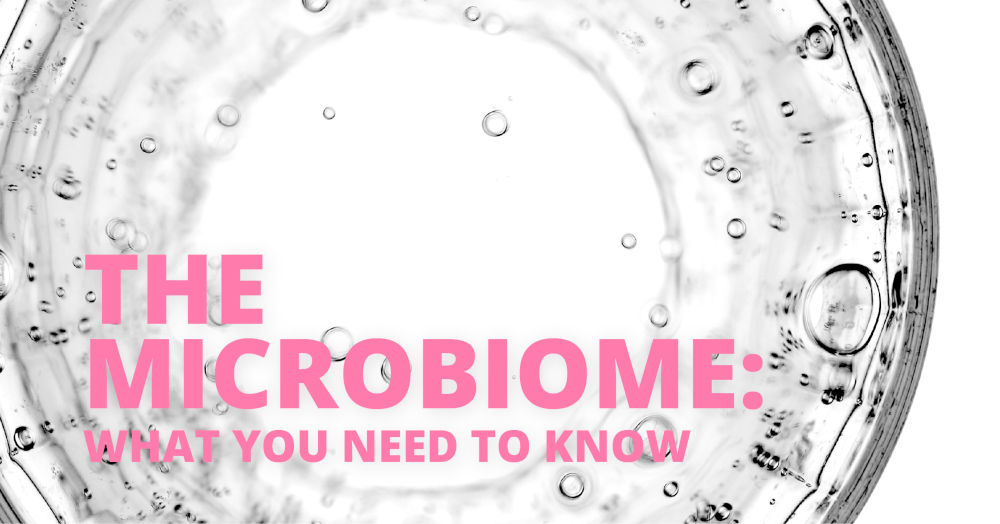
The Microbiome: What You Need to Know
About 100 trillion bacteria, both good and bad, are currently living inside your digestive system. Paired with other tiny organisms like viruses and fungi, they make up what’s known as the microbiome.
Each person’s microbiome is unique to them. Your microbiome is decided by your mother’s microbiome – the environment that you’re exposed to at birth – as well as your diet, environment and lifestyle.
Although many different types of microbes live inside you, bacteria are the most studied. Interestingly, there are more bacterial cells in your body (40 trillion) than human cells (30 trillion) (1). While bacteria make a home for themselves in all areas of your body, those residing in your gut have the biggest influence on your health.
As many as 1,000 species of bacteria live in the human gut microbiome, and each of them plays a different role in your body.
Some bacteria are ‘good’: they help to fight inflammation and have a positive influence on everything from innate immunity to appetite and energy metabolism, whereas ‘bad’ bacteria promote inflammation and may cause disease (2). When the gut is working at its best, the good and bad bacteria keep each other in check. But when this becomes imbalanced, the ’bad’ bacteria take charge, producing metabolites (substances needed for metabolism) that spread to the gut lining and the bloodstream, extending the inflammation to various parts of the body (3).
Certain bacteria types can have a severe impact on health. Some have been linked to a lower immune function; others to increased risk of allergies, or even to chronic illnesses like diabetes (2), heart disease (4) and some cancers (5). Importantly, your gut is responsible for how your body extracts and absorbs nutrients from your diet, so a poorly functioning microbiome may leave you lacking important nutrients.
To summarise, your microbiome is involved in the following key areas:
- Mental health
- Cardiovascular health
- Immunity
- Weight management
- Blood-sugar balance
- Digestion
- Inflammation
How to Support your Microbiome
We need to look after our microbiome to maintain a healthy physiological balance, and for optimal health and wellbeing. Diet, environmental factors, stress and medications can all disrupt this balance, undermining the diversity of your gut microbiome. Here are some ways to provide support for your microbiome and its delicate balance
1. Prebiotics
Prebiotics are fibres and natural sugars that support the good bacteria in the gut and encourage the development of a diverse community of microbes (6). These foods are complex carbohydrates, such as vegetables and whole grains, including onions, garlic, asparagus, banana and Jerusalem artichoke.
2. Probiotics
Probiotics are substances or preparations containing beneficial live bacteria (‘good bacteria’) that populate your gut and fight off bad bacterial strains. As they travel through the digestive system, probiotics positively impact the microbiome using similar mechanisms as our native microbes to enhance health. Probiotics may also offer preventive and therapeutic support, helping to restore the healthy composition and function of the gut microbiome (7).
Good food sources include live yoghurt and fermented foods such as sauerkraut, kimchi and miso. If regularly consuming probiotic foods is a challenge for you, supplementation is a good option; Udo’s Choice Super 8 Microbiotics contain eight bacterial strains, with each vegetarian capsule containing 42 billion viable cells.
For those who prefer a liquid option, Symprove is a water-based food supplement containing four strains of live and activated bacteria, which are delivered to the gut to support the microbiome.
Alongside the benefits offered to general health, a particularly good time to take probiotics is after completing a course of antibiotics which can upset the good gut bacteria.
3. Choose whole grains
Quinoa, oats and other whole grains contain dietary fibres that cannot be broken down by your intestines. They reach your colon intact, where they become food for the microbes and can help boost their populations (8). Other good sources include whole-grain rice, brown bread, rye bread and buckwheat.
4. Spice it up
Early research suggests that adding antibacterial spices like garlic, ginger, black pepper, cumin and turmeric to your dishes can help stem the rise of ‘bad’ bacteria in your gut (9).
5. Pick polyphenols
Dark chocolate (ideally over 70% cocoa) is full of fibre and molecules called polyphenols, which microbes can use for fuel. Polyphenols are plant compounds with anti-inflammatory properties that can help reduce blood pressure and cholesterol levels, and are broken down by the microbiome to stimulate healthy bacterial growth (10). Besides chocolate, common sources of polyphenols include red grapes, artichoke, green tea, olive oil and cherries.
6. An apple a day…
A recent study has found that green apples boost good gut bacteria (11). While you’ll certainly benefit from eating them raw, interesting research has shown that eating stewed apples may be particularly rewarding for your microbiome, and can be healing to the gut too.
7. Only take antibiotics when you really need to
Antibiotics and over-the-counter medications like the contraceptive pill and NSAIDs kill good as well as bad bacteria. So try to avoid taking them whenever possible (but only when it’s safe to do so) (12).
With its key role in supporting digestion and boosting your immune system, the gut microbiome is crucial for a healthy gut along with many other areas of health. An imbalance of good and bad microbes in the intestines may result in weight gain, imbalanced blood sugar and other issues. So, to help support the healthy gut microbes, eat plenty of fresh fruits, vegetables, whole grains, spices and fermented foods and avoid antibiotics when possible.
References
1) Sender, Ron, et al. (2016) ‘Revised Estimates for the Number of Human and Bacteria Cells in the Body.’ PLOS Biology, vol. 14, no. 8, [Online]. Available at https://pmc.ncbi.nlm.nih.gov/articles/PMC4991899/ (Accessed: 16 Oct. 2019)
2) Proctor, LM., et al. (2014) ‘The Integrative Human Microbiome Project: Dynamic Analysis of Microbiome-Host Omics Profiles during Periods of Human Health and Disease.’ Cell Host & Microbe, vol. 16, no. 3, pp. 276–289, [Online] Available at https://pubmed.ncbi.nlm.nih.gov/25211071/ (Accessed: 19 Oct. 2019)
3) Vivarelli, Silvia, et al. (2019) ‘Gut Microbiota and Cancer: From Pathogenesis to Therapy.’ Cancers, vol. 11, no. 1, p. 38, [Online] Available at https://pmc.ncbi.nlm.nih.gov/articles/PMC6356461/ (Accessed: 19 Oct. 2019)
4) Wang, Zeneng, et al. (2011) ‘Gut Flora Metabolism of Phosphatidylcholine Promotes Cardiovascular Disease.’ Nature, vol. 472, no. 7341, pp. 57–63, [Online] Available at https://pmc.ncbi.nlm.nih.gov/articles/PMC3086762/ (Accessed: 30 Oct. 2019)
5) Gagnière, Johan, et al. (2016) ‘Gut Microbiota Imbalance and Colorectal Cancer.’ World Journal of Gastroenterology, vol. 22, no. 2, p. 501, [Online] Available at https://pmc.ncbi.nlm.nih.gov/articles/PMC4716055/ (Accessed: 31 Oct. 2019)
6) Gagliardi, A., et al. (2017) ‘Effects of Probiotics, Prebiotics, and Synbiotics on Human Health.’ Nutrients, vol. 9, no. 9, p. 1021, [Online] Available at https://pmc.ncbi.nlm.nih.gov/articles/PMC5622781/ (Accessed: 19 Oct. 2019)
7) Hemarajata, Peera, and James Versalovic, (2012) ‘Effects of Probiotics on Gut Microbiota: Mechanisms of Intestinal Immunomodulation and Neuromodulation.’ Therapeutic Advances in Gastroenterology, vol. 6, no. 1, pp. 39-51, [Online]. Available at https://pmc.ncbi.nlm.nih.gov/articles/PMC3539293/ (Accessed: 16 Oct. 2019)
8) Costabile, Adele, et al. (2008) ‘Whole-Grain Wheat Breakfast Cereal Has a Prebiotic Effect on the Human Gut Microbiota: A Double-Blind, Placebo-Controlled, Crossover Study.’ The British Journal of Nutrition, vol. 99, no. 1, pp. 110–20, [Online] Available at https://pubmed.ncbi.nlm.nih.gov/17761020/ (Accessed 31 Oct. 2019)
9) Peterson, Christine T., et al. (2019) ‘Prebiotic Potential of Culinary Spices Used to Support Digestion and Bioabsorption.’ Evidence-Based Complementary and Alternative Medicine, vol. 2019, pp. 1–11, [Online]. Available at https://pmc.ncbi.nlm.nih.gov/articles/PMC6590564/ (Accessed 30 Oct. 2019)
10) Cardona, Fernando, et al. (2013) ‘Benefits of Polyphenols on Gut Microbiota and Implications in Human Health.’ The Journal of Nutritional Biochemistry, vol. 24, no. 8, pp. 1415–22, [Online] Available at https://pubmed.ncbi.nlm.nih.gov/23849454/, (Accessed 29 Oct. 2019)
11) Koutsos, Athanasios, et al. (2015) ‘Apples and Cardiovascular Health—Is the Gut Microbiota a Core Consideration?’ Nutrients, vol. 7, no. 6, pp. 3959-3998, [Online] Available at https://pmc.ncbi.nlm.nih.gov/articles/PMC4488768/ (Accessed 2 Mar. 2019)
12) Bailey, L. Charles, et al. (2014) ‘Association of Antibiotics in Infancy With Early Childhood Obesity.’ JAMA Pediatrics, vol. 168, no. 11, p. 1063, [Online] Available at https://pubmed.ncbi.nlm.nih.gov/25265089/ (Accessed 15 Oct. 2019)


